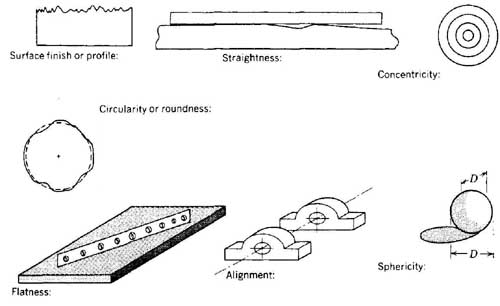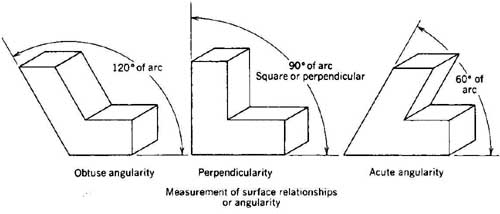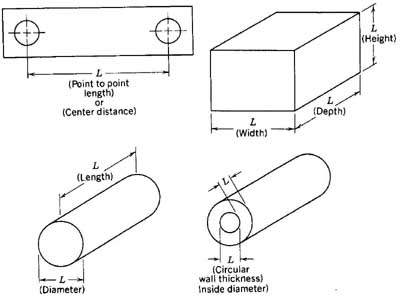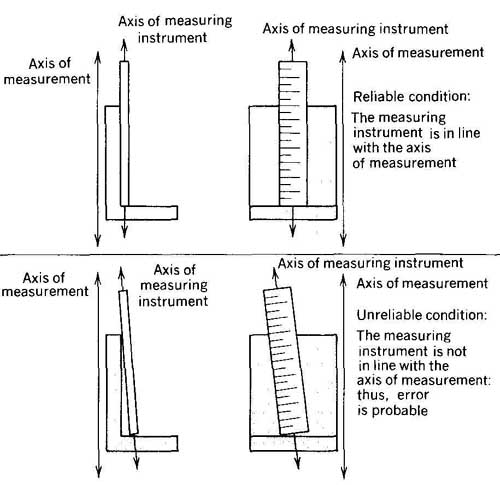AMAZON multi-meters discounts AMAZON oscilloscope discounts
All of us, no matter what we may be doing, are actually surrounded by measurement. Measurement can be generally defined as the assignment of a value to time, length, and mass. We cannot escape measurement. Our daily lives are greatly influenced by the clock, a device that measures time. Mass or weight is measured in almost every product we buy, and the measure of length is incorporated in every creation of humans, ranging from the minute components of a watch to many thousands of miles of superhighways extending across a continent.
Measurement, in the modern age, has been developed to an exact science known as metrology. As the hardware of technology has become re complex, a machinist is ever more concerned with that branch of the science called dimensional metrology. Furthermore, mass production of goods has made necessary very complex systems of metrology to check and control critical dimensions that control standardization and interchangeability of parts. Components of an automobile, for example, may be manufactured at locations far removed from each other and then brought to a central assembly point, with the assurance that all parts will fit as intended by the designer. In addition, the development and maintenance of a vast system of carefully controlled measurement has permit ted manufacturers to locate their factories close to raw materials and available labor. Because of the standardization of measurement, industry has been able to diversify its products. Thus, manufacturers can do what they do best, and manufacturing effort can be directed toward the quality of a product and its production at a competitive price. As a result, metrology affects not only the technical aspects of production but also the economic aspects. Metrology is a common thread woven through the entire fabric of manufacturing from the drafting room to the shipping dock. The units in this section illustrate and demonstrate most of the common measuring tools used in machining technology. Even though you may never see all of these tools in your experiences, you should study this material carefully since the subject of precision measurement is common to all the machine shop activities described in this entire text.
This section also covers the subjects of tolerances, fits, geometric dimensions, and an introduction to statistical process control (SPC).
These topics are equally essential to the modern machinist especially in the age of computer-assisted manufacturing (CNC and CAM). Much of your work as a machinist will be dedicated to meeting dimensional specification on the parts that you make, both in part size arid part geometry. Meeting tolerance specification in machining in turn permits the correct fit between parts in precision assemblies and thus the proper performance of these parts and assemblies in complex machines and other equipment.
There is every possibility that your career will be involved with some phase of high-precision, computer-controlled machining equipment (CNC) either as an operator, setup person, inspector, computer part programmer, or possibly a manufacturing engineer. Statistical process control (SPC) will play an important part in all phases of computer-assisted manufacturing where high-precision machining production is used. Therefore, the modern machinist must also be familiar with the tools and methods of SPC activities.
Measurement Needs of the Machinist
A machinist is mainly concerned with the measurement of length; that is, the distance along a line between two points ( FIG. C-1). It is length that defines the size of most objects. Width and depth are simply other names for length. A machinist measures length in the basic units of linear measure such as inches, millimeters, and, in advanced metrology, wavelengths of light. In addition, the machinist sometimes needs to measure the relationship of one surface to another, which is commonly called angularity ( FIG. C-2).
= = = =

FIG. C-1 The measurement of length may appear under several different names.
Flatness: Flatness is the deviation of a surface from a true plane. Flatness is generally a multiaxis measurement
Straightness: Straightness refers to the deviation of a surface from a true line. Straightness is generally a single axis measurement
Concentricity: Concentricity refers to two more circles with the same center The measurement of deviation from true concentricity may be called indicated runout or eccentricity
Surface finish or profile: Measurement of surface roughness.
Circularity or roundness: Circularity refers to the conformity to the true circle. Measured deviation from true circularity may be known as out of round, indicating the presence or absence of lobes.
Alignment: Alignment determines the degree to which two or more components are colinear (along the same line). Alignment may refer to separate components or features of the same component (distortion)
Sphericity: Sphericity is the measurement diameter and circularity in air planes.
= = = ==
Squareness, which is closely related to angularity, is the measure of deviation from true perpendicularity. A machinist will measure angularity in the basic units of angular measure, degrees, minutes, and seconds of arc.
= = = =

FIG. C-2 Measurement of surface relationships or angularity.
= = = =

FIG. C-3 Other measurements encountered by the machinist.
= = = =
In addition to the measure of length and angularity. a machinist also needs to measure such things as surface finish, concentricity, straightness, and flatness. He or she also occasionally comes in contact with measurements that involve circularity, sphericity, and alignment (FIG. C-3). However, many of these more specialized measurement techniques- are in the realm of the inspector or laboratory metrologist and appear infrequently in general machine shop work.
General Principles of Metrology
A machinist has available a large number of measuring tools designed for use in many different applications. However, not every tool is equally suited for a specific measurement. As with all the tools of a machinist, selecting the proper measuring tool for the specific application at hand is a primary skill. The successful outcome of a machinist’s work may indeed depend upon the choice of measuring tools. In this regard, a machinist must be familiar with several important terms and principles of metrology.
Accuracy
Accuracy in metrology has a twofold meaning. First, accuracy can refer to whether or not a specific measurement is actually within its stated size. For example, a certain drill has its size stamped on its shank. A doubtful machinist decides to verify the drill size using a properly adjusted micrometer. The size is found to be as stated. Therefore, the size stamped on the drill is accurate. Second, accuracy refers to the act of measurement itself with regard to whether or not the specific measurement taken is within the capability of the measuring tool selected. A machinist obtains a drill with the size marked on the shank and decides to verify it using a steel rule. The edge of this rule with the finest graduations is selected; the machinist then lays the drill over the marks. Sighting along the drill, one discovers that it is really three graduations, on his rule, smaller than the size stamped on the shank. He then reasons that the size marked on the drill must be in error. In this example, the act of measurement is not accurate because the inappropriate measuring tool was selected and the improper procedure was used. User accuracy is also an important consideration. If, when the machinist measured the drill with his micrometer, as described in the first example, he did not bother to confirm the accuracy of the instrument prior to making the measurement, an inaccuracy that can be attributed to the user may have resulted.
PRECISION
The term precision is relative to the specific measurement being made, with regard to the degree of exactness required. For example, the distance from the earth to the moon, measured to within one mile, would indeed be a precise measurement. Likewise, a clearance of five-thousandths of an inch between a certain bearing and journal might be precise for that specific application. However, five-thousandths of an inch clearance between ball and race on a ball bearing would not be considered precise, as this clearance would be only a very few millionths of an inch. There are many degrees of precision dependent on application and design requirements. For a machinist, any measurement made to a degree finer than one sixty-fourth of an inch or one-half millimeter can be considered a precision measurement and must be made with the appropriate precision measuring instrument.
RELIABILITY
Reliability in measurement refers to the ability to obtain the desired result to the degree of precision required. Reliability is most important in the selection of the proper measuring tool. A certain tool may be reliable for a certain measurement, but totally unreliable in another application. For example, if it were desired to measure the distance to the next town, the odometer on an automobile speedometer would yield quite a reliable result, provided a degree of precision of less than one-tenth mile is not required. On the other hand, to measure the length of a city lot with an odometer is much less likely to yield a reliable result. This is explained by examining another important principle of metrology, that of the discrimination of a measuring instrument.
DISCRIMINATION
Discrimination refers to the degree to which a measuring instrument divides the basic unit of length it is using for measurement. The automobile odometer divides the mile into 10 parts: therefore, it discriminates to the nearest tenth of a mile. A micrometer, one of the most common measuring instruments of a machinist, sub divides an inch into 1000 or, in some cases, 10,000 parts. Therefore, the micrometer discriminates to .001 or .0001 of an inch. If a measuring instrument is used beyond its discrimination, a loss of reliability will result. Consider the example cited previously regarding the measurement of a city lot. Most lots are less than one-tenth of a mile in length: therefore, the discrimination of the auto odometer for this measurement is not sufficient for reliability.
THE 10:1 RATIO FOR DISCRIMINATION
In general, a measuring instrument should discriminate 10 times finer than the smallest unit that it will be asked to measure. The odometer, which discriminates to a tenth of a mile, is most reliable for measuring whole miles. To measure the length of a city lot in feet requires an instrument that discriminates at least to one-tenth of a foot. Since most surveyors’ measuring tapes used for this application discriminate to tenths and in some cases to hundredths of a foot, they are an appropriate tool for the measurement.
THE POSITION OF A LINEAR MEASURING INSTRUMENT WITH REGARD TO THE AXIS OF MEASUREMENT
A large portion of the measurements made by a machinist is linear in nature. These measurements attempt to determine the shortest distance between two points. In order to obtain an accurate and reliable linear measurement, the measuring instrument must be exactly in line with the axis of that measurement. If this condition is not met, reliability will be in question. The alignment of the measuring instrument with the axis of measurement applies to all linear measurements ( FIG. C-4). The FIG. illustrates the alignment of the instrument with the axis of measurement using a simple graduated measuring device. Only under the reliable condition can the measurement approach accuracy. Misalignment of the instrument, as illustrated in the unreliable situation, will result in inaccurate measurements.
===

FIG. C-4 The axis of a linear measuring instrument must be in line with the
axis of measurement.
===
RESPONSIBILITY OF THE MACHINIST IN MEASUREMENT
The units in this section discuss most of the common measuring tools available to a machinist. The capabilities, discrimination, and reliability as well as procedures for use are examined. It is, of course, the responsibility of a machinist to select the proper measuring instrument for job at hand. When faced with a need to measure, a machinist should ask the following questions:
1. What degree of accuracy and precision must measurement meet?
2. What degree of measuring tool discrimination does this required accuracy and precision demand?
3. What is the most reliable tool for this application?
CALIBRATION Accurate and reliable measurement places a considerable amount of responsibility on a machinist. He or she is responsible for the conformity of his or her measuring tools to the appropriate standards. This is the process known as calibration. In a large industrial facility, all measuring tools are periodically cycled through the metrology laboratory where they are calibrated against appropriate standards. Any adjustments are then made to bring the tools into conformity to the standards.
Only through this process can standardized measure within an individual plant or within an entire industrial nation be maintained. Most of the common measuring instruments provide a factory standard. Even though calibration can’t be carried out under laboratory conditions, instruments should at least be checked periodically against available standards.
VARIABLES IN MEASURING A machinist should be further aware that any measurement is relative to the conditions under which it is taken. A common expression that is often used around the shop is: “the measurement is right on.” There is, of course, little probability of getting a measurement that is truly exact. Each measurement has a certain degree of deviation— from the theoretical exact size. This degree of error is dependent on many variables including the measuring tool selected, the procedure used, the temperature of the part, the temperature of the room, the cleanliness of the room air, and the cleanliness of the part at the time of measurement. The deviation of a measurement from exact size is taken into consideration by the designer. Every measurement has a tolerance, meaning that the measurement is accept able within a specific range. Tolerance can be quite small depending on design requirements. When this condition exists, reliable measurement becomes more difficult because it is more heavily influenced by the many variables pre sent. Therefore, before a machinist makes any measurement, he or she should stop for a moment and consider the possible variables involved. He or she should then consider what might be done to control as many of these variables as possible.
If you understand these basic principles of dimensional metrology and you assume the proper responsibility in the selection, calibration, and application of measuring instruments, you will experience little difficulty in performing the many measurements encountered in the science of machine tools and machining practices.
Tools for Dimensional Measurement
There are several hundred measuring instruments available to a machinist. In this modern age there is a measuring instrument that can be applied to almost any conceivable measurement. Many instruments are simply variations and combinations of a few common precision measuring tools. As you begin your study of machine tool practices, you will be initially concerned with the use, care, and applications of the common measuring instruments found in the ma chine shop. These will be discussed in detail within this section.
In addition to these, there is a large variety of instruments that are designed for many specialized uses. Some of these are rarely seen in the school or general purpose machine shop. Others are intended for use in the tool room or metrology laboratory where they are used in the calibration process. Your contact with these instruments will depend on the particular path you take while learning the trade.
Many measuring instruments have under gone modernization in recent years. Even though the function of these tools is basically the same, many have been redesigned and equipped with mechanical or electronic digital displays. These features make the instruments easier to read and improve accuracy. As a machinist, you must be skilled in the use of all the common measuring instruments. In addition, you should be familiar with the many important instruments used in production machining, inspection, and calibration. In the following pages many of these tools will be briefly described so that you may become familiar with the wide selection of measuring instruments available to the machinist.